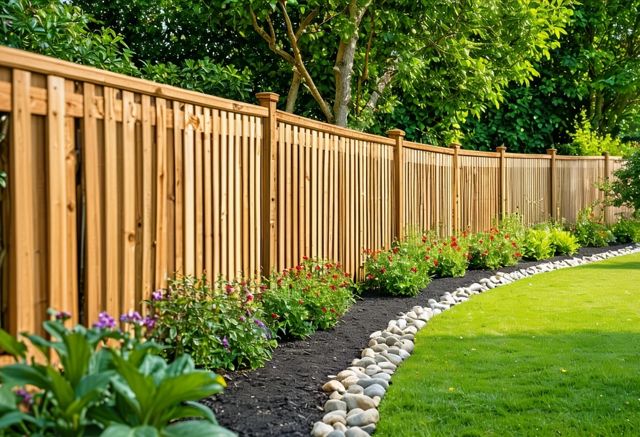Choosing cost-effective wood fence solutions includes using pressure-treated wood or pallet fences, which are affordable and durable options. DIY installation and using recycled materials can further reduce overall costs significantly.
1. Choosing the Right Wood Type
Exploring different wood types for fencing can help balance cost and durability. Common options include:
- Pressure-Treated Wood: At $12 – $20 per linear foot, it’s affordable and treated to resist decay and insects, ensuring a long life.
- Split Rail Fence: Costs range from $11 – $29 per linear foot. It’s easy to install and maintain, suitable for rural settings, and can be made from various woods.
- Pallet Fence: An eco-friendly choice at $10 – $20 per linear foot. It repurposes materials for a rustic look.
DIY installation can cut costs significantly. While hiring professionals might cost $2,400 to $3,200, doing it yourself can reduce expenses to $1,000 to $1,300 for quality materials. Attending instructional classes and renting essential tools, like an auger for post holes, can simplify the process.
To extend the lifespan of your wooden fence, seal it before installation using high-quality sealants. Avoid pre-made panels; building a fence board by board is often cheaper and more durable. Clear the installation area yourself, remove old fences, and reuse materials when possible to save money and comply with local building codes.

2. DIY vs Professional Installation
When choosing between DIY wood fence installation and hiring professionals, it’s essential to evaluate both costs and benefits.
DIY Installation:
- Cost Savings: Significantly lower costs as you’ll only pay for materials.
- Flexibility: Work at your own pace and avoid scheduling conflicts.
- Personal Satisfaction: Sense of accomplishment from completing a project yourself.
- Challenges: Requires time, tools, and some level of expertise. Mistakes can lead to additional costs and frustration.
Professional Installation:
- Expertise: Access to experienced installers ensuring high-quality workmanship.
- Time Efficiency: Projects are completed faster without compromising quality.
- Warranty: Many professionals offer warranties, giving you peace of mind.
- Cost: Higher initial expense due to labor charges.
Understanding the potential savings and challenges helps in making an informed decision. DIY can be budget-friendly but demanding, while professionals offer convenience and reliability at a higher cost. Each option has its unique advantages depending on your needs and capabilities.
3. Money-Saving Installation Tips
Discover practical tips for reducing installation costs, such as buying materials in bulk, planning the layout effectively, and using recycled or reclaimed wood.
Reducing installation costs starts with smart planning. Begin by purchasing materials in bulk. Bulk buying often provides discounts, cutting down your overall expenses.
Effective layout planning is also crucial. Measure your yard accurately and draft a layout, considering the boundaries and any obstacles. This minimizes waste and avoids over-purchasing materials.
Using recycled or reclaimed wood is another excellent way to save money:
- Reclaimed Pallets: Often available for free from nurseries or construction sites. Ensure they have the IPPC logo to avoid pest issues.
- Recycled Timber Logs: Use split rail designs to reduce material usage while maintaining aesthetic appeal.
By focusing on these strategies, you can significantly reduce your wood fence installation costs without compromising on quality and appearance.

4. Affordable Maintenance Strategies
Proper maintenance can greatly extend the life of your wood fence and keep costs down. Here are some effective strategies:
- Sealing: Applying a high-quality sealant protects the wood from moisture and UV damage. Make sure to reseal your fence every 2-3 years.
- Cleaning: Regularly clean your fence with a mild detergent and water. This helps prevent mold, mildew, and dirt buildup, which can deteriorate the wood.
- Repairs: Address any issues as soon as they arise. Replace loose or damaged boards promptly to prevent small problems from escalating.
By following these maintenance practices, property owners can ensure their fences remain in good condition, reducing the need for costly repairs down the line. Consider Pickets’ wood fence solutions for expert craftsmanship and durable fencing options tailored to your needs.

FAQ
What are the common wood types for cost-effective fencing?
Exploring different wood types for fencing can help balance cost and durability. Common options include pressure-treated wood, split rail fences, and pallet fences.
How much does pressure-treated wood cost?
Pressure-treated wood costs between $12 – $20 per linear foot. It’s affordable and treated to resist decay and insects, ensuring a long life.
What is a split rail fence, and how much does it cost?
A split rail fence costs between $11 – $29 per linear foot. It’s easy to install and maintain, suitable for rural settings, and can be made from various woods.
Is a pallet fence an eco-friendly option?
Yes, a pallet fence is an eco-friendly choice that costs between $10 – $20 per linear foot. It repurposes materials for a rustic look.
How can I save costs with DIY wood fence installation?
DIY installation can significantly cut costs. While hiring professionals might cost $2,400 to $3,200, doing it yourself can reduce expenses to $1,000 to $1,300 for quality materials.
What tools are essential for DIY installation?
Attending instructional classes and renting essential tools, like an auger for post holes, can simplify the DIY fence installation process.
Should I build a fence with pre-made panels or board by board?
Building a fence board by board is often cheaper and more durable than using pre-made panels.
What are some alternative fencing options to wood?
Considering alternatives like chain link fences combined with plants or vinyl fences can offer cost savings. Chain link fences are durable, while vinyl fences require less maintenance over time.
What are the benefits of DIY wood fence installation?
DIY installation offers significant cost savings, flexibility, a sense of personal satisfaction, but it requires time, tools, and some level of expertise.
Why should I consider professional installation?
Professional installation ensures high-quality workmanship, time efficiency, warranties, and peace of mind, though it comes at a higher initial cost due to labor charges.
How can buying materials in bulk reduce installation costs?
Buying materials in bulk often provides discounts, cutting down your overall expenses for wood fence installation.
Why is effective layout planning important?
Effective layout planning minimizes waste and avoids over-purchasing materials, which helps reduce installation costs.
Where can I find recycled or reclaimed wood?
Reclaimed pallets are often available for free from nurseries or construction sites. Ensure they have the IPPC logo to avoid pest issues. Recycled timber logs are also an excellent choice for reducing material usage while maintaining aesthetic appeal.
How often should I seal my wood fence?
Applying a high-quality sealant and resealing your fence every 2-3 years protects the wood from moisture and UV damage.
How can regular cleaning benefit my wood fence?
Regularly cleaning your fence with a mild detergent and water helps prevent mold, mildew, and dirt buildup, which can deteriorate the wood.
Why is prompt repair important for wood fences?
Addressing issues as soon as they arise, such as replacing loose or damaged boards, prevents small problems from escalating, ensuring the fence remains in good condition and reducing the need for costly repairs.

